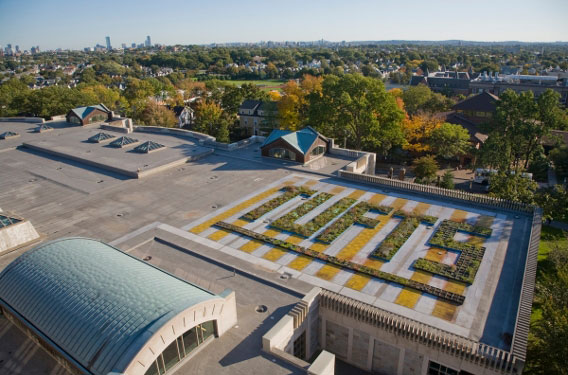Greening the Rooftop
A garden on top of Tisch Library is a biology student’s proving ground for urban environmentalism
By Marjorie Howard
Three years ago, graduate student Colleen Butler—with lots of help from the facilities department—created a roof garden on the top of Tisch Library, hauling up 20,000 pounds of soil and plants, which spent a hot, dry summer on the roof. “The short story is the sedum lived, and everything else died,” she says.

Because they bake under a hot sun, roof gardens can be tricky to maintain, creating a challenge for gardeners. Photo: Alonso Nichols
Sedum is a succulent, meaning it stores water in its leaves and can thrive without a lot of water. Since the summer of 2007, Butler, who is pursuing a doctorate in biology, has been learning more about roof gardens and what will thrive and what won’t.
Roof gardens help keep buildings cooler in the summer and warmer in the winter. They act as natural filters because the plants remove contaminants such as nitrogen and phosphorous from rainwater and carbon dioxide from the air. They also keep rainwater from washing into storm drains and sewer systems, where it is treated unnecessarily at wastewater treatment plants, often at great cost to municipalities.
The green roof industry touts what these gardens can accomplish and what grows best, but there has been little research to verify the claims, says Colin Orians, Butler’s advisor and a professor of biology. Because they bake under a hot sun, roof gardens can be tricky to maintain, creating a challenge for gardeners. For example, one day in August 2009, when the temperature was 90 degrees, the Tisch rooftop reached 156 degrees, and the soil in the plant containers was 151 degrees. The soil where sedum was growing, however, was considerably cooler, at 113 degrees, says Butler.
Sedum can act as what’s called a “nurse plant” by cooling the soil for other species, says Butler. Nurse plants, in which one species assists another, exist in many forms in nature. One example comes in salt marshes along the East Coast, where a species that can tolerate salinity grows and sequesters some of the salt, making the area tolerable for other plants, says Orians. In the Northwest, the Olympic Rain Forest is dry in the summer, so seedlings germinate in downed logs, where they are able to gather more moisture.
To learn whether sedum could serve as a nurse plant, Butler planted mint and milkweed with and without sedum companions in the summer of 2008. She is still collecting data, but so far has found that in wet conditions, sedum acts as a competitor, reducing the growth of a neighboring plant. In hot, dry conditions, though, sedum acts as a facilitator, increasing the survival of neighboring plants.
Orians says he can imagine an urban herb garden where sedum can help facilitate the growth of oregano, sage, mint and rosemary.
Meanwhile, Butler has been meeting with two Somerville aldermen, Rebekah Gewirtz and Maryann Heuston, who have proposed establishing a Green Community and Open Space task force to increase green roof opportunities in Somerville, which spends $11.5 million annually to send storm water and sewage to a treatment facility. Butler estimates that a small commercial building of 15,000 square feet could save $2,250 a year in storm water treatment, while a larger commercial building, about 50,000 square feet, would save $7,500 per year.
Butler will continue to analyze the data from her Tisch roof garden. In addition to focusing on science, she is now viewing roof gardens from a different angle, as a botanist for Apex Green Roofs, a Somerville-based company that designs and maintains roof gardens.
See a related story as the project began: http://tuftsjournal.tufts.edu/archive/2007/november/corner/index.shtml.
Marjorie Howard can be reached at marjorie.howard@tufts.edu.


